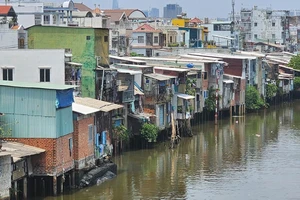 HCMC carries out ADB-funded project to control air pollution from transportation
HCMC carries out ADB-funded project to control air pollution from transportation
At the same time, the project also proposes prioritized activities to manage emission sources causing air pollution in the southern metropolis.
Every time of stop lights or a traffic jam, drivers breathe exhaust fume from vehicles; worse, they are daily exposed to black smoke coming from old trucks, buses and motorbikes while driving their vehicles to work. Every day, going back and forth across Cong Hoa Street from Thu Duc City to District 12, Ms. Lan Anh fears being stuck in traffic jams on the way on hot days especially when her motorbike is behind old buses, motorbikes, and cars.
Mr. Cao Tung Son, Head of Meteorology - Hydrology and Climate Change Sub-Division under the Department of Natural Resources and Environment of Ho Chi Minh City, acknowledged that the southern metropolis is facing the risk of air pollution from motor vehicles, industrial activities, and construction, outdoor burning of garbage. Air pollution is causing many impacts on health, ecology and climate. In order to reduce air pollution, city administrations have been formulating many plans. Specifically, the city Department of Natural Resources and Environment has implemented the ADB-funded project to improve capacity and take action to improve air quality in August 2019.
For the implementation of the project TA9608-REG in HCMC, US$250,000 non-refundable aid is spent. Key project activities include conducting a city-level air quality study focusing on current air quality, impact, and management, and identifying measures to address air pollution including technology selection, policy incentives, and capacity support.
Moreover, the project also prepares a city-level clean air action plan. With the aim to support environmental protection as well as improve air pollution in the city, the People's Committee of Ho Chi Minh City has approved the project technical assistance to improve capacity and action to improve air quality. The Department of Natural Resources and Environment was assigned to liaise with the project's consultant.
Mr. Tom Buckland, Deputy Director of the TA9608-REG project, said that HCMC has been facing difficulties related to air quality management. The current sources of air pollution in the southern largest city come from industrial emissions, road traffic, and emission from residential areas and transportation is the main source of emissions.
Project TA9608-REG’s research has shown that NO2 emissions in traffic mainly come from trucks ( 35 percent), cars (32 percent) and motorbikes (20 percent) meanwhile SO2 emissions mainly come from cars (57 percent), trucks (24 percent), motorbikes (11 percent). The project also discovered that 35 percent, 34 percent, and 25 percent of PM10 dust emissions come from motorcycles, cars, and trucks respectively. Furthermore, 40 percent, 32 percent and 16 percent of PM2.5 dust emissions mainly come from trucks, motorbikes, and cars.
Mr. Tom Buckland warned that the area with high traffic density has more emissions. Pollutants such as NO2 can affect lung function and respiratory symptoms while PM10 and PM2.5 dust cause respiratory disease, cardiovascular disease and death, adversely affecting health and SO2 causes airway constriction, potentially affecting people with asthma, and chronic lung disease.
The TA9608-REG project team also proposed scenarios and activities to act with the aim of managing air pollutant emissions more effectively. Proposed activities include converting motorbikes to electric vehicles, and expansion of restricted areas for vehicles comprising of cars and fuel converters for truck.
According to the scenario, if 50 percent of motorbikes are converted to electric vehicles, it will help improve from one percent- six percent NO2 concentrations, one percent-10 percent PM10, and six percent PM2.5 emissions into the environment.
Meanwhile, in the extended scenario, if 50 percent of cars are restricted, it will help reduce five percent NO2, three percent SO2, six percent PM10, and two percent PM2.5 concentrations in the environment.
The scenario of fuel conversion for trucks also contributes significantly to reducing emissions into the environment.
In addition to solutions for vehicles and fuel conversion in traffic activities, the TA9608-REG project also focuses on raising awareness for the community with goals such as increasing people’s understanding of the impact of air pollution on their health conditions.
Plus, the project aims to increase the number of people who grasp information about air quality, raise awareness about sources of air pollution and encourage people to take practical actions to reduce air pollution and reduce exposure to air pollution. Last but not least, at the same time, the project expanded communication on the clean air website in Ho Chi Minh City, Facebook, and leaflets.
























